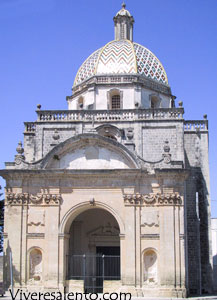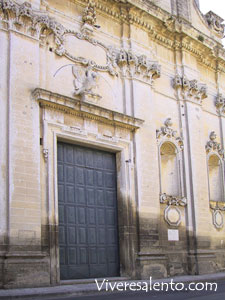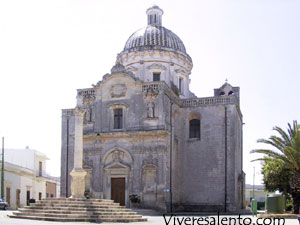|
|

The Palaces of Lequile are certainly worth visiting. The most
important palace is certainly the Palace of
 the
Princes Saluzzo. It is in St Vito Square and has several large rooms, a
well-furnished library and a beautiful façade with a finely decorated portal. It
was enlarged in the 17th century but the previous structure is certainly older.
In the Palace there is also a charming Chapel dedicated to St George that was
built in 1742 according to the will of the Prince Agostino Saluzzo. In the same
square the tourist can notice the Spire of St Vito, an interesting sculpture in
baroque style. The statue of the saint is made in our stone and was carved by
Oronzo Rossi in 1694. Filippi Palace dates to the 16th century and has an
elegant portal with a statue representing the head of a horse, the coat-of-arms
of this family. Andreoli Palace has also a stately portal and dates to the 16th
century. Caiaffa Palace was built in the 17th century and is characterised by a
typical balcony with ornamental brackets. Another interesting stone-balcony is
that of Brunetti Palace (17th century). In the historic centre the tourist
should also visit the ‘case a corte’, a kind of houses typical in the Salento.
The Mother church is also here in the historic centre and is dedicated to Our
Lady of the Assumption. The church was finished in 1746 and was built on a older the
Princes Saluzzo. It is in St Vito Square and has several large rooms, a
well-furnished library and a beautiful façade with a finely decorated portal. It
was enlarged in the 17th century but the previous structure is certainly older.
In the Palace there is also a charming Chapel dedicated to St George that was
built in 1742 according to the will of the Prince Agostino Saluzzo. In the same
square the tourist can notice the Spire of St Vito, an interesting sculpture in
baroque style. The statue of the saint is made in our stone and was carved by
Oronzo Rossi in 1694. Filippi Palace dates to the 16th century and has an
elegant portal with a statue representing the head of a horse, the coat-of-arms
of this family. Andreoli Palace has also a stately portal and dates to the 16th
century. Caiaffa Palace was built in the 17th century and is characterised by a
typical balcony with ornamental brackets. Another interesting stone-balcony is
that of Brunetti Palace (17th century). In the historic centre the tourist
should also visit the ‘case a corte’, a kind of houses typical in the Salento.
The Mother church is also here in the historic centre and is dedicated to Our
Lady of the Assumption. The church was finished in 1746 and was built on a older pre-existing structure. It is an aisleless church and the Latin Cross plan was
made by Mauro Manieri in 1723. Inside there are beautiful altars such as that of
the Virgin of the Rosary. The beautiful wooden statue representing Our Lady of
the Assumption is very interesting. It was made by Oronzo Rossi and is now on
the high altar. The dome of this church looks very interesting and the bell
tower too. This latter is a five-floor building was finished in 1896 by the
architect Russo. The Sanctuary of Saint Mary of the Consolation dates to the
1600 and was built in an elegant baroque style. The façade is very sober and it
has a simple portal and a statue of the Virgin. Inside the tourist can still
admire the rests of an old fresco representing Our Lady with the Child. The
Church of St Nicola, also known as Church of the Redeemer, dates to the 17th
century. It has a Greek cross plan and was built in baroque style. The beautiful
17th century façade has a large portal. Inside there are beautiful altars and a
wonderful fresco of 1692. Another interesting element is the octagonal dome with
its small pieces of coloured ceramics. The church of St Vito was built between
1661 and 1670 and was planned by Salvatore Miccoli. It has a Greek cross plan
and a beautiful dome. The façade is decorated with the
pre-existing structure. It is an aisleless church and the Latin Cross plan was
made by Mauro Manieri in 1723. Inside there are beautiful altars such as that of
the Virgin of the Rosary. The beautiful wooden statue representing Our Lady of
the Assumption is very interesting. It was made by Oronzo Rossi and is now on
the high altar. The dome of this church looks very interesting and the bell
tower too. This latter is a five-floor building was finished in 1896 by the
architect Russo. The Sanctuary of Saint Mary of the Consolation dates to the
1600 and was built in an elegant baroque style. The façade is very sober and it
has a simple portal and a statue of the Virgin. Inside the tourist can still
admire the rests of an old fresco representing Our Lady with the Child. The
Church of St Nicola, also known as Church of the Redeemer, dates to the 17th
century. It has a Greek cross plan and was built in baroque style. The beautiful
17th century façade has a large portal. Inside there are beautiful altars and a
wonderful fresco of 1692. Another interesting element is the octagonal dome with
its small pieces of coloured ceramics. The church of St Vito was built between
1661 and 1670 and was planned by Salvatore Miccoli. It has a Greek cross plan
and a beautiful dome. The façade is decorated with the
 statues
of the Saints while inside there are nine paintings on sacred subjects. The
Franciscan Monastery was built in the 17th century probably by Brother
Silvestro. This is a stately building with a nice cloister and a small well. The
wooden refectory and the 17th century frescos are also very interesting. The
Church of St Basilio Magno was built in the 17th century when the close Church
of St Mary of the Star was knocked down. The Chapel of Our Lady of
Constantinople dates to the 1639 and is very simple both inside and outside.
Outside the urban area the tourist can visit the rests of the old farms such as
Masseria Libelli and Masseria Tramacere. The patron saint of Lequile is St Vito
and the population celebrates him on the fourth Sunday of June. statues
of the Saints while inside there are nine paintings on sacred subjects. The
Franciscan Monastery was built in the 17th century probably by Brother
Silvestro. This is a stately building with a nice cloister and a small well. The
wooden refectory and the 17th century frescos are also very interesting. The
Church of St Basilio Magno was built in the 17th century when the close Church
of St Mary of the Star was knocked down. The Chapel of Our Lady of
Constantinople dates to the 1639 and is very simple both inside and outside.
Outside the urban area the tourist can visit the rests of the old farms such as
Masseria Libelli and Masseria Tramacere. The patron saint of Lequile is St Vito
and the population celebrates him on the fourth Sunday of June.

The nickname of the people of Lequile is "toad eater". In the
past, the young men of San Pietro (a close village) came to Lequile in order to
court the young girls of this village. The young men of Lequile did not like
this situation at all, they used to meet the others in the countryside in the
nearby of a pond, where they used to ‘settle their matters’ fighting. The young
men of San Pietro insulted the others calling them ‘toad eaters’ and this is own
the nickname was created.
|